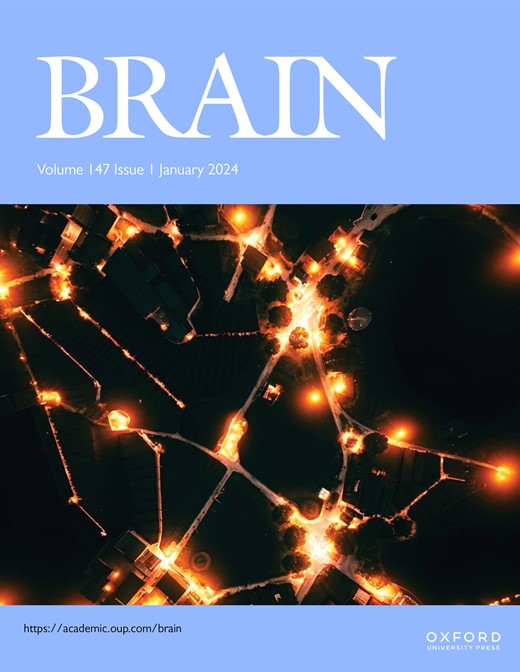小血管疾病的氧萃取率:与疾病负担和进展的关系
IF 10.6
1区 医学
Q1 CLINICAL NEUROLOGY
引用次数: 0
摘要
慢性脑灌注不足被认为是脑血管病的主要发病机制。尽管如此,脑组织可增加氧提取分数以减轻缺氧和延迟实质损伤。本研究旨在探讨脑小血管疾病的氧萃取率及其与疾病负担和进展的关系。我们回顾性地纳入195例脑血管疾病患者和178例正常对照。采用动脉自旋标记法测定脑血流。通过定量敏感性作图和定量血氧水平依赖成像来估计氧提取分数。我们比较了患者和对照组之间的基线脑血流量和全白质、正常白质和白质高信号的氧提取分数。然后,我们研究了不同疾病负担患者的脑血流量和氧提取分数是否存在差异。纵向上,我们使用线性混合模型来评估脑血流量和氧提取分数是否可以共同预测47例患者白质高信号或游离水的进展(平均随访时间= 2.6年)。与对照组相比,患者组表现为全脑白质血流量减少,白质表现正常,白质高信号。此外,在正常白质中,氧提取分数增加,而在白质高信号中,氧提取分数减少。值得注意的是,在轻中度疾病负担患者中,白质氧提取分数升高,而在最严重疾病负担患者中,白质氧提取分数下降。纵向分析显示,在脑血流测量中加入氧提取分数测量可以改善疾病进展的预测。较高的脑血流基线值和白质中氧提取分数都与较慢的自由水增加有关。综上所述,在脑血管疾病患者中,氧提取分数表现出“先增加后减少”的模式。氧提取分数和脑血流量可以共同预测疾病进展。无创MRI评价氧提取分数可为今后脑血管疾病的研究提供有价值的工具。本文章由计算机程序翻译,如有差异,请以英文原文为准。
Oxygen extraction fraction in small vessel disease: relationship to disease burden and progression
Chronic hypoperfusion has been considered a major mechanism of cerebral small vessel disease. Nonetheless, brain tissue may increase oxygen extraction fraction to mitigate hypoxia and delay parenchymal damage. This study aims to investigate oxygen extraction fraction in cerebral small vessel disease and understand its relationship to disease burden and progression. We retrospectively included 195 patients with cerebral small vessel disease and 178 normal controls. Cerebral blood flow was measured by arterial spin labelling. Oxygen extraction fraction was estimated by quantitative susceptibility mapping plus quantitative blood oxygen-level dependence imaging. We compared baseline cerebral blood flow and oxygen extraction fraction in the whole white matter, normal-appearing white matter and white matter hyperintensities between the patient and control groups. Then, we studied whether cerebral blood flow and oxygen extraction fraction differed among patients with varying disease burdens. Longitudinally, we used linear mixed models to evaluate whether cerebral blood flow and oxygen extraction fraction could together predict the progression of white matter hyperintensities or free water (mean follow-up time = 2.6 years) in a subset of 47 patients. Compared to the control group, the patient group exhibited reduced cerebral blood flow in the whole white matter, normal-appearing white matter and white matter hyperintensities. Additionally, the oxygen extraction fraction increased in normal-appearing white matter but decreased in white matter hyperintensities. Notably, the white matter oxygen extraction fraction was elevated in patients with mild-to-moderate disease burden but decreased in those with the most severe disease burden. Longitudinal analyses revealed that adding oxygen extraction fraction measurements to cerebral blood flow measurements can improve the prediction of disease progression. Higher baseline values of cerebral blood flow and oxygen extraction fraction in the white matter were both linked to a slower increase in free water. In summary, oxygen extraction fraction exhibited an ‘increase-then-decrease’ pattern in patients with cerebral small vessel disease. Together, oxygen extraction fraction and cerebral blood flow can predict disease progression. Non-invasive MRI assessment of oxygen extraction fraction may provide valuable tools for future research on cerebral small vessel disease.
求助全文
通过发布文献求助,成功后即可免费获取论文全文。
去求助
来源期刊

Brain
医学-临床神经学
CiteScore
20.30
自引率
4.10%
发文量
458
审稿时长
3-6 weeks
期刊介绍:
Brain, a journal focused on clinical neurology and translational neuroscience, has been publishing landmark papers since 1878. The journal aims to expand its scope by including studies that shed light on disease mechanisms and conducting innovative clinical trials for brain disorders. With a wide range of topics covered, the Editorial Board represents the international readership and diverse coverage of the journal. Accepted articles are promptly posted online, typically within a few weeks of acceptance. As of 2022, Brain holds an impressive impact factor of 14.5, according to the Journal Citation Reports.
 求助内容:
求助内容: 应助结果提醒方式:
应助结果提醒方式:


